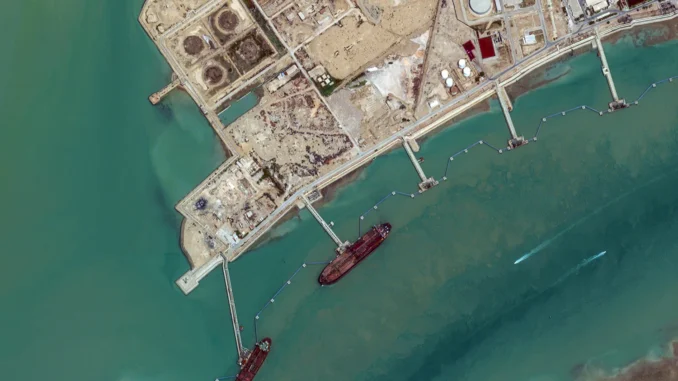
And why that could change.
Energy markets, stoked by days of highly telegraphed Iranian threats of reprisal attacks against Israel, were primed to erupt this week. Instead, once the dust settled from Iran’s largely ineffective drone-and-missile barrage on Israel on Saturday, traders let out less of a bang than a whimper.
Crude oil prices in London and New York both slipped in trading Monday, underscoring how fears that the escalation of a shooting war in the Middle East involving one of the world’s biggest oil producers seemed—for now, at least—overblown. The Iranian attacks did not target any Israeli energy infrastructure, and while Tehran got an assist from allied Houthi militants in Yemen, those strikes were aimed at Israel itself, not against the Red Sea shipping that has been the Houthis’ target of choice since October.
The market was underwhelmed because nothing that happened over the weekend was any worse for energy markets in a practical sense than everything else that has been happening since Hamas’s Oct. 7 attack. Iran and its proxies are still shooting at Israel, which is still in a war against Hamas. The Houthis are still harassing shipping in the Red Sea and driving away many Western oil companies, but the militants haven’t shot at any tankers yet. Iran’s periodic threats to close the even more strategic chokepoint in the Strait of Hormuz have been as hollow as all their other threats to do so in the past few decades.
Oil traders had already pushed up the price of crude from the low $70s a barrel to about $90 a barrel since early December, with the biggest jump in the last few weeks, anticipating the worst. And the worst hasn’t happened yet. It still could, though, especially as the United States and Israel gear up their respective responses to Iran’s reprisals.
“There’s reduced but not eliminated geopolitical risk,” said Richard Bronze, a co-founder and head of geopolitics at Energy Aspects, a research consultancy based in London. “Prices falling a little makes sense, but don’t expect them to go back to where they were at the beginning of the year, just because this particular confrontation didn’t blow up.”
Oil markets have learned to roll with geopolitical crises in a way that was unthinkable years ago, when the mere hint of a major escalation in the Middle East would spook crude futures and find U.S. presidents looking to release strategic reserves of petroleum. Part of that sanguinity can be chalked up to changes in how the global oil market is supplied. The biggest producer in the world is the United States, and the growth in global oil supplies this year and next will come from the United States and other countries in the Americas such as Brazil, Canada, and Guyana. And global demand for oil, while still growing, is slowing down as the world works off its post-pandemic splurge.
The upshot is that the global oil market, while hardly oversupplied, is not taut as a barrel, either. Thanks to OPEC and its partners’ self-discipline in curbing output, there is plenty of spare oil production capacity in the global market—an emergency buffer (though one hard to activate just now) that keeps oil markets a little more relaxed than headlines might suggest.
But the worst could yet come to pass. With the global oil supply-and-demand balance still finely matched and OPEC+ determined to keep production in check to nudge up prices, there is still scope for a political or geopolitical shock or two to roil oil markets. And there are plenty in store.
“I don’t think we can look at Iran and Israel in isolation. Venezuela sanctions are due to lapse this week. Ukraine continues to target Russian refineries. Congress is looking at sanctions on Iran’s exports to China,” said Kevin Book, the managing director of ClearView Energy Partners, a Washington-based energy consultancy. “The oil market is like a tightly wound French poodle, running at 97 percent capacity when it is happy, so it doesn’t take much of a yank on its leash to make it yap.”
First, key oil chokepoints are still in the crosshairs. The Houthis are still harassing shipping in the Red Sea and the Bab el-Mandeb strait, through which 12 percent of global seaborne supplies of crude passes. And they are still shooting at ships, if not at oil tankers. U.S. Central Command reports a steady drumbeat of Houthi drones and anti-ship missiles that keep U.S. and coalition ships busy in the narrow waterway.
And Iran is still capable of causing trouble in the Strait of Hormuz, an even more vital waterway on the other side of Saudi Arabia through which most Saudi and Kuwaiti crude and almost all of Iran’s crude must pass. Iranian forces seized an Israel-linked ship there on Saturday, and Iranian military commanders last week reiterated yet again that the country could try to close Hormuz as a way to pressure the United States and Israel. (Closing the Strait of Hormuz is not as easy as Iran might think, yet opening it is not as painless as the United States might wish.)
Second, Israel has vowed retaliation for Iran’s reprisal attack, though the timing and shape of such a strike are yet to be determined. Analysts expect that Israel will likely target Iranian military assets, either with cyberweapons or a military strike. An Israeli attack on Iranian oil-producing facilities—considered civilian targets, even if they are vital to Tehran’s military budget—looks less likely but isn’t entirely out of the question. (Ukraine has taken the war to Russia’s oil patch in a bid to hit the Kremlin where it hurts.)
Any follow-up attack on Iran’s oil industry could spell trouble for a market that is just managing to get by without much help from OPEC or its members. Iran showed the biggest production growth in the otherwise output-cutting cartel last year and is now—despite nominal U.S. sanctions—producing about 3.2 million barrels of oil a day.
There are a couple of other risks to oil prices that don’t involve blowing things up. The U.S. Congress is considering a slate of additional potential sanctions to levy against Iran, including one bill that would take aim at Chinese banks that help Iran trade oil. It’s a precisely targeted measure: China imports about one-third of Iranian oil and accounts for virtually the entirety of Iran’s newfound export growth. Book estimated that such a measure, if enacted and enforced, could jack up oil prices by close to 10 percent, or something on the order of about $8 a barrel.
The Biden administration is not eager to see higher oil prices in an election year. It has made that clear to Ukraine, repeatedly warning Kyiv not to attack critical Russian oil assets, lest pump prices in the United States creep up by a quarter a gallon. But congressional stampedes, especially when it comes to whacking Iran, can be hard to resist and are often veto-proof, Book noted.
There’s one further sanctions-related risk to oil prices. European parties to the Joint Comprehensive Plan of Action, the Iran nuclear deal that the United States is no longer a party to, could call for a veto-proof snapback of sanctions at the United Nations. Such a move would further tighten the screws on newly rejuvenated Iranian oil exports, which would make an already almost-tight oil market genuinely tighter.
“When there is an anticipated period of tightness, the market adjusts, but when there is a gradual tightening in the background, and something happens, you can wake up and find the market $10 higher,” Bronze said.



